-
Low-Power Sensor Measurements: 3.3V, 1Ksps, 12-Bit, Single-Ended, Dual-Supply Circuit
Low-Power Sensor Measurements: 3.3V, 1Ksps, 12-Bit, Single-Ended, Dual-Supply Circuit
Design Goals
| Input | ADC Input | Digital Output ADS7042 |
|---|---|---|
| VinMin = 0V | AIN_P = 0V, AIN_M = 0V | 000H or 010 |
| VinMax = 3.3V | AIN_P = 3.3V, AIN_M = 0V | FFFH or 409610 |
| AVDD | Vee | Vdd |
|---|---|---|
| 3.3V | –0.3V | 4.5V |
Design Description
This design shows an low-power amplifier being used to drive a SAR ADC that consumes only nW of power during operation. This design is intended for systems collecting sensor data and require a low-power signal chain which only burns single-digit µW of power. PIR sensors, gas sensors, and blood glucose monitors are a few examples of power-sensitive systems that benefit from this SAR ADC design. The values in the component selection section can be adjusted to allow for different data throughput rates and different bandwidth amplifiers. Low-Power Sensor Measurements: 3.3V, 1ksps, 12-bit Single-Ended, Single Supply shows a simplified version of this circuit where the negative supply is grounded. The –0.3-V negative supply in this example is used to achieve the best possible linear input signal range. See SAR ADC Power Scaling for a detailed description of trade-offs in low-power SAR design.
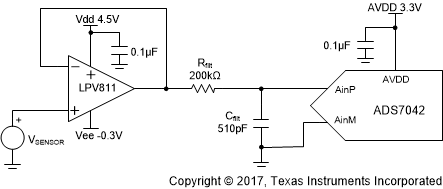
Specifications
| Specification | Calculated | Simulated | Measured |
|---|---|---|---|
| Transient ADC Input Settling (1ksps) | < 0.5 × LSB = 402µV | 41.6µV | N/A |
| AVDD Supply Current (1ksps) | 230nA | N/A | 214.8nA |
| AVDD Supply Power (1ksps) | 759nW | N/A | 709nW |
| VDD OPAMP Supply Current | 450nA | N/A | 431.6nA |
| VDD OPAMP Supply Power | 2.025µW | N/A | 1.942µW |
| AVDD + VDD System Power (1ksps) | 2.784µW | N/A | 2.651µW |
Design Notes
- Determine the linear range of the op amp based on common mode, output swing, and linear open loop gain specification. This is covered in the component selection section.
- Select a COG (NPO) capacitor for Cfilt to minimize distortion.
- The TI Precision Labs – ADCs training video series covers methods for selecting the charge bucket circuit Rfilt and Cfilt (see Introduction to SAR ADC Front-End Component Selection). These component values are dependent on the amplifier bandwidth, data converter sampling rate, and data converter design. The values shown here provide good settling and AC performance for the amplifier and data converter in this example. Modifying the design requires selection of a different RC filter.
Component Selection
- Select a low-power op amp:
- Supply current < 0.5µA
- Gain bandwidth product > 5kHz (five times the sampling rate)
- Unity gain stable
- LPV811 – 450-nA supply current, 8-kHz gain bandwidth product, unity gain stable
- Find op amp maximum and minimum
output for linear operation:
- Typical power calculations (at
1ksps) with expected values. See SAR ADC Power Scaling for a detailed
description of trade-offs in low-power SAR design:
- Typical power calculations (at
1ksps) with measured values:
- Find Rfilt and Cfilt to allow for settling at 1ksps. Refer to Refine the Rfilt and Cfilt Values (a Precision Labs video) for the algorithm to select Rfilt and Cfilt. The final value of 200kΩ and 510pF proved to settle to well below ½ of a least significant bit (LSB).
DC Transfer Characteristics
The following graph shows a linear output response for inputs from 0 to 3.3V. The full-scale range (FSR) of the ADC falls within the linear range of the op amp. Refer to Determining a SAR ADC’s Linear Range when using Operational Amplifiers for detailed theory on this subject.
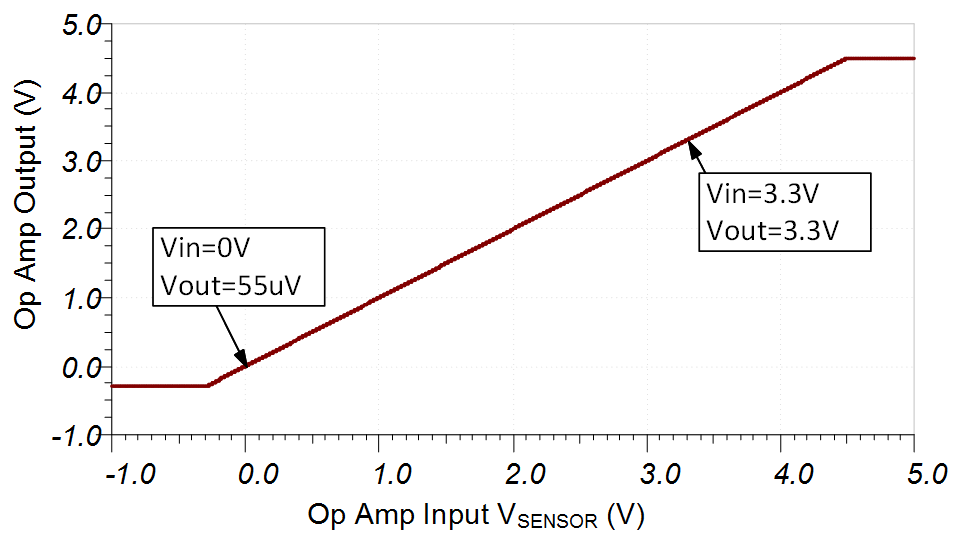
AC Transfer Characteristics
The bandwidth simulation includes the effects of the amplifier output impedance and the RC charge bucket circuit (Rfilt and Cfilt).The bandwidth of the RC circuit is shown in the following equation as 1.56kHz. The simulated bandwidth of 2 kHz includes effects from the output impedance interacting with the impedance of the load. See TI Precision Labs - Op Amps: Bandwidth 1 for more details on this subject.
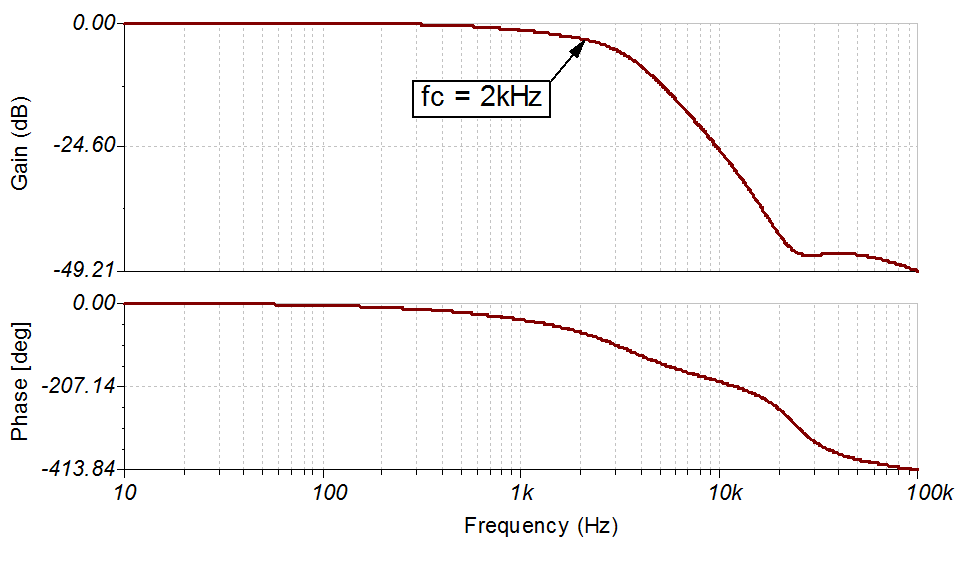
Transient ADC Input Settling Simulation
The following simulation shows settling to a 3-V DC input signal. This type of simulation shows that the sample and hold kickback circuit is properly selected to within ½ of an LSB (402µV). Refer to Introduction to SAR ADC Front-End Component Selection for detailed theory on this subject.
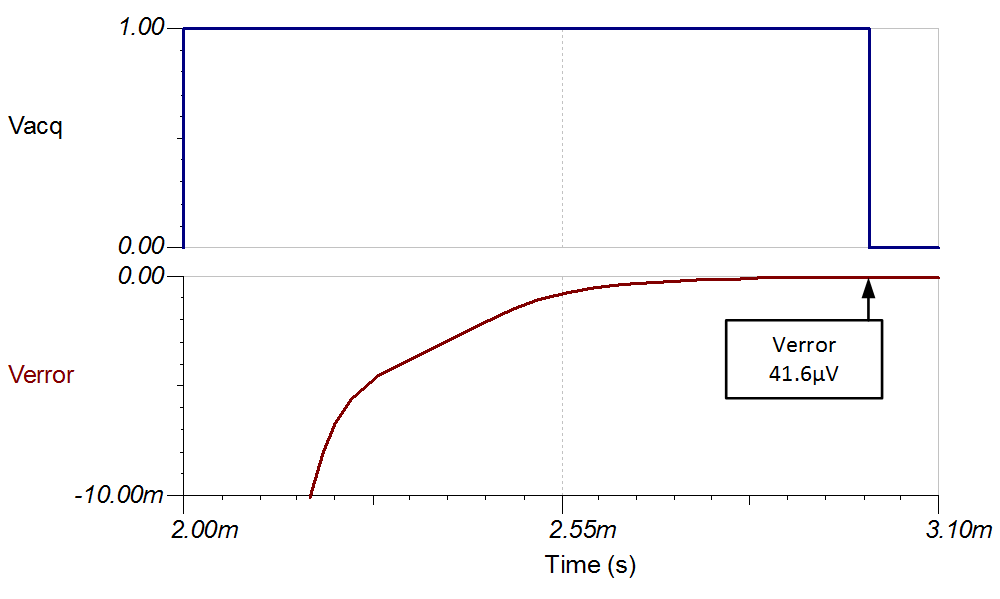
Noise Simulation
This section walks through a simplified noise calculation for a rough estimate. The resistor noise in this calculation is neglected because it is attenuated for frequencies greater than 10 kHz.
Note that the calculated and simulated values match well. Refer to Calculating the Total Noise for ADC Systems for detailed theory on this subject.
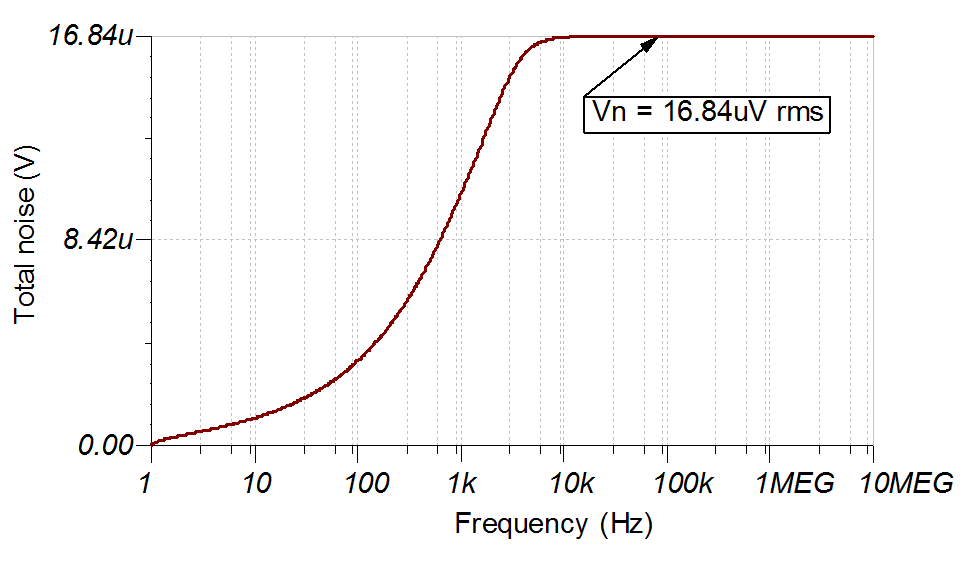
Measure FFT
This performance was measured on a modified version of the ADS7042EVM with a 10-Hz input sine wave. The AC performance indicates SNR = 71.0dB, THD = –82.4dB, and ENOB (effective number of bits) = 11.51, which matches well with the specified performance of the ADC, SNR = 70dB and THD = –80dB. This test was performed at room temperature. See Introduction to Frequency Domain for more details on this subject.
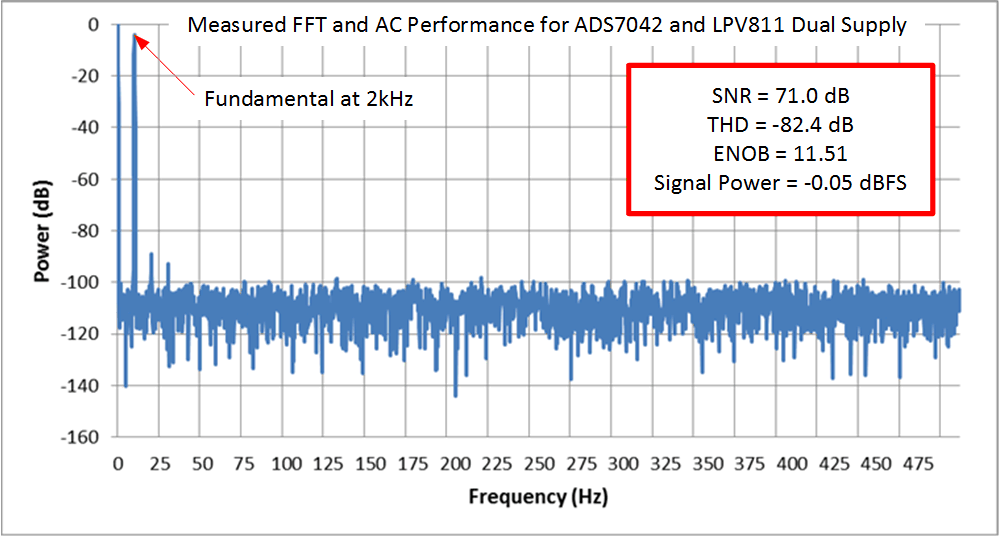
Design Featured Devices
| Device | Key Features | Link | Similar Devices |
|---|---|---|---|
| ADS7042(1) | 12-bit resolution, SPI, 1-Msps sample rate, single-ended input, AVDD reference input range 1.6V to 3.6V. | 12-Bit 1MSPS Ultra-Low-Power Ultra-Small-Size SAR ADC With SPI Interface | Analog-to-digital converters (ADCs) |
| LPV811(2) | 8-kHz bandwidth, rail-to-rail output, 450-nA supply current, unity gain stable | Single Channel 450nA Precision Nanopower Operational Amplifier | Operational amplifiers (op amps) |
Link to Key Files (TINA)
Texas Instruments, SBAM342 circuit, design files
Revision History
Changes from Revision A (March 2019) to Revision B (September 2024)
- Updated the format for tables, figures, and cross-references throughout the documentGo
Trademarks
All trademarks are the property of their respective owners.
IMPORTANT NOTICE AND DISCLAIMER
TI PROVIDES TECHNICAL AND RELIABILITY DATA (INCLUDING DATASHEETS), DESIGN RESOURCES (INCLUDING REFERENCE DESIGNS), APPLICATION OR OTHER DESIGN ADVICE, WEB TOOLS, SAFETY INFORMATION, AND OTHER RESOURCES “AS IS” AND WITH ALL FAULTS, AND DISCLAIMS ALL WARRANTIES, EXPRESS AND IMPLIED, INCLUDING WITHOUT LIMITATION ANY IMPLIED WARRANTIES OF MERCHANTABILITY, FITNESS FOR A PARTICULAR PURPOSE OR NON-INFRINGEMENT OF THIRD PARTY INTELLECTUAL PROPERTY RIGHTS.
These resources are intended for skilled developers designing with TI products. You are solely responsible for (1) selecting the appropriate TI products for your application, (2) designing, validating and testing your application, and (3) ensuring your application meets applicable standards, and any other safety, security, or other requirements. These resources are subject to change without notice. TI grants you permission to use these resources only for development of an application that uses the TI products described in the resource. Other reproduction and display of these resources is prohibited. No license is granted to any other TI intellectual property right or to any third party intellectual property right. TI disclaims responsibility for, and you will fully indemnify TI and its representatives against, any claims, damages, costs, losses, and liabilities arising out of your use of these resources.
TI’s products are provided subject to TI’s Terms of Sale (www.ti.com/legal/termsofsale.html) or other applicable terms available either on ti.com or provided in conjunction with such TI products. TI’s provision of these resources does not expand or otherwise alter TI’s applicable warranties or warranty disclaimers for TI products.
Mailing Address: Texas Instruments, Post Office Box 655303, Dallas, Texas 75265
Copyright © 2024, Texas Instruments Incorporated